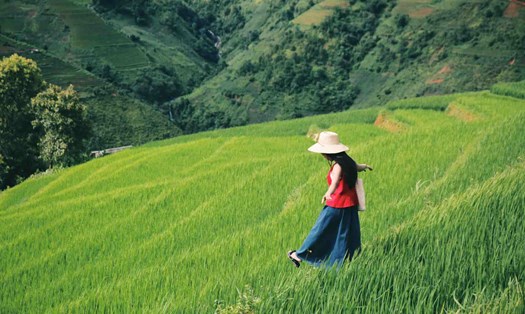The beauty of terraced fields in the vast land of Muong
The terraced fields are a testament to the creativity and perseverance of highland people in adapting to steep terrain. In mountainous communes of Phu Tho province after the merger, such as Thuong Coc (formerly Mien Doi commune), Muong Thang (formerly Thach Yen), Hop Phong (formerly Xuan Phong), or hamlets in Tan Lac commune, terraced fields are not only a method of cultivation but also a unique cultural and landscape mark.
Nearly 10 years ago, when the writer first set foot in Mung hamlet, Hop Phong commune, the road was still bumpy with gravel and rocks. joy was then one of the most disadvantaged neighborhoods in the province. But the terraced fields of the people are a bright spot in the midst of poverty. Now, Hop Phong has changed, community tourism is taking shape in Mung hamlet, which is considered the "rooftop" of the commune. With its isolated location, beautiful terraced fields and still pristine, this place is becoming a destination for tourists inside and outside the province.
Continuing the journey, Muong Thanh commune has emerged as a traditional countryside, notably Rom Khanh hamlet, which has the largest and most beautiful terraced fields in the locality. According to Mr. Bui Van Tuong, a cadre of Muong Thang commune, this rice field is only about 10 minutes by car from the commune center.
Here, the fields extend to the foot of the hill, below are small streams flowing all year round, above are the terraces of stilt houses scattered along the mountainside. Every early morning, the first rays of sunlight shine through each plot of rice fields, reflecting on the water surface, creating a peaceful and poetic scene.
Mr. Bui Van Nhung's family lives next to the field, sharing: "This terraced field has existed for a long time. Since our ancestors were born. When the rice season comes, the aroma is stuffy. We are proud that the fields not only produce food, but also attract many people to take photos and sightsee.
From Muong Thang, it only takes about 20 minutes to follow the red dirt road to Thuong Coc, which is considered the heart of the terraced fields of Muong. The terrain here is heavily divided by steep hills, most of the cultivated land is terraced fields. The most beautiful are the poor nearby in Voi Thuong and Dom, where hundreds of fields are winding, seamless from the foot of the mountain to the top. In the middle are primeval forests and stilt houses that still retain traditional architecture.
Standing from Le Hill, the roof of the upper castle, you can see the whole of Cong Hoa (formerly belonging to Lac Son), Tan Lac, Muong Thang and the vast terraced rice valley at your feet.
Preserving cultural values from terraced fields
Not only beautiful in landscape, terraced fields are also associated with the livelihood and traditional cultural life of the Muong people. Returning to the Thuong Coc in mid-July when the summer-autumn rice crop was already thick and green.
The entire lush green field is filled with vitality, and the steep floor-roofed houses are hidden. Here, we met many households that still maintain traditional lifestyles, from stilt house architecture to farming and living methods. Some families still preserve the ancient gong set of the family from previous generations.
In Thuong Coc, over the years, people have restored the native tangerine growing model that was once famous in the region. Mixed with production, people have also begun to welcome guests to experience.
According to Mr. Bui Van Bich, a cadre of Thuong Coc commune, in recent years, the commune has welcomed many groups of visitors to visit and experience terraced fields. However, tourism service conditions have not been invested in, mainly due to people developing themselves. If there is proper investment in infrastructure and other conditions, tourism has potential for development.
According to Mr. Bich, from Thuong Coc, you can continue your journey to explore the ancient Muong land with many other famous landmarks, such as Mu Waterfall and Bai Bui grassland. With available potential, localities such as Thuong Coc and Muong Thang can completely develop community tourism associated with cultural preservation and improving livelihoods. The ripe rice seasons, the bustling atmosphere of harvesting, drying rice, threshing rice... are all vivid images, with high aesthetic value, very attractive to visitors when spread on social networks or in real-life experience tours.
It is known that in October 2022, the People's Committee of the old Hoa Binh province conducted a survey, evaluation and research to prepare a dossier for the conservation of the World Cultural and Natural Heritage "Large rice fields of the Muong Hoa Binh people" in the old Tan Lac, Lac Son and Cao Phong districts. After the merger of administrative boundaries, although the place names have changed, the cultural and natural values of terraced fields are still intact.
In particular, in October 2024, the terraced fields festival associated with the OCOP product promotion market was held in Thuong Coc commune, the locality with the most terraced fields in the ancient Muong region. The event attracted thousands of people inside and outside the province to participate. In the bustling space of the festival, visitors can admire the beauty of terraced fields in the ripe rice season, enjoy traditional cuisine and experience the life of Muong village.
Ms. Nguyen Thi Mai, a tourist from Hanoi, shared: I have been to Mu Cang Chai and Hoang Su Phi, but when I arrived at Thuong Coc, I was really surprised. Here, the fields are not as high as in the North, but in return, they are very harmonious, close, surrounded by green forests, Muong villages with streams flowing continuously".
For the Muong people in the highlands, terraced fields are not only means of production, but also a place to preserve memories, traditions and community identity. Preserving and promoting the value of those fields not only helps develop the economy but also contributes to preserving culture, a valuable thing that is not easy to regain if left unused.









